Mt. Everest Expedition - South Col
Approach and Route
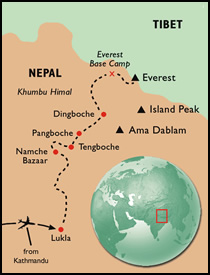
By the time you arrive at the base camp at the foot of the Khumbu Icefall, a route will already be established with ropes and ladders through the icefall to Camp 1, and our strong Sherpa team will be ferrying loads of equipment up the mountain. On your first stage of acclimatization, you'll spend several days at and above Camp 2. A day-climb up the Lhotse Face towards Camp 3 (7,300m/23,700ft) will complete this first foray before returning to Base Camp. The second trip on to the mountain will involve either ‘tagging’ or sleeping a night at Camp 3 for acclimatisation before returning to base camp for a rest period. The most likely time for our summit climb will be between 15 and 25 May. We will climb through the established camps with lightweight packs and don our oxygen masks for the first time when we arrive at Camp 3 (7,300m/23,700ft) to sleep. We then climb to Camp 4 (7,950m/26,300ft) on the South Col. All climbers will be sleeping on bottled oxygen before setting out for the summit, carrying only very lightweight Russian oxygen bottles and using Summit masks. Sherpas and Western guides will accompany all members during the summit climb.
The expedition will be organized in such a way to allow members to concentrate largely on their own health and performance, without the burden of load carrying or dealing with logistics. A doctor experienced in high altitude medicine will be resident at base camp throughout the expedition to monitor your acclimatization and provide for your health care.
To gain a full understanding of your body's response to altitude and to gain experience with Himalayan conditions, we recommend you join us for two expeditions prior to Everest (Alaska's Denali and Tibet's Cho Oyu are our top choices for your preparatory steps to the summit of Everest). Please see our web site for more details on these expeditions or call us to discuss our Seven Summits Training Program.
Route
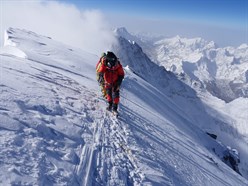
The final steps.
AAI Collection
We climb Everest via the South Col route from Nepal in the spring season because this route and timing offer the absolute best chance of success. Routes from the north are technically more difficult, especially as you climb higher on the mountain. In the spring climbing season, we gain the dual advantages of getting progressively milder weather as we move closer to the summit and of climbing more stable slopes because the winter winds have scoured away much of the snow, significantly reducing the avalanche hazard.
This expedition is a joint American Alpine Institute /AC Expedition. The Institute has the most extensive and successful high altitude guiding record in the world, and AC has the highest success rate guiding on Mt. Everest. The companies in these programs share guides and administrative duties to bring you meticulous preparation. From expert Sherpas and support staff, to careful menu planning, oxygen support, satellite communication, environmental protection, and a mountain clean-up plan, our expedition is finely tuned to Leave No Trace while offering you the highest possible chances for success.
Mt. Everest Expedition - South Col
Safety and Success
The AAI / Adventure Consultants Alliance
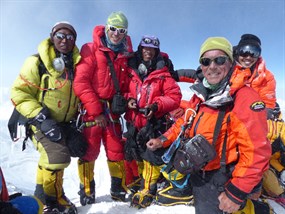
On the summit with our talented guide team. AAI/AC Collection
The American Alpine Institute strives to provide the highest quality service and leadership to our climbers around the world. On certain expeditions, we reach out to our partners to combine resources and offer an experience unmatched by any other guide service. This is a joint expedition with our partner Adventure Consultants. We work together to share the load of administrative and guide-related duties that go into such a complicated expedition.
We employ strong, specialized expedition leaders and support staff, whom are some of the most pre-eminent in the industry. We pride ourselves on operating with small teams and the best back-up and support available. This includes nutritious and ample quantities of food, comfortable base camp facilities, reliable communications systems and the necessary medical back up.
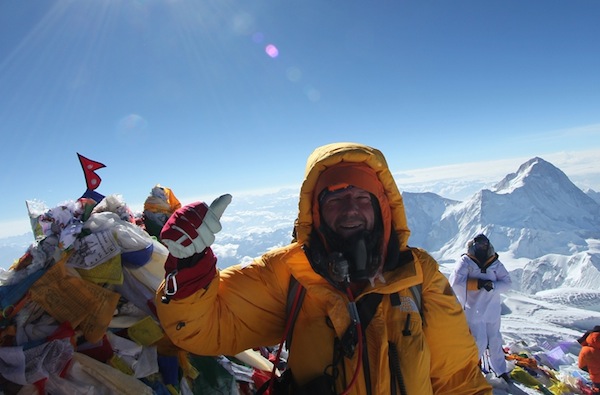
Dean Staples on his 9th summit of Everest in 2013. AAI/AC Collection
Why climb with AAI and AC?
The success of an expedition is often determined by factors that are planned well in advance of the actual climbing; the many years spent fine-tuning the operational blue print for this expedition has led to a high proportion of our expedition members reaching the summit.
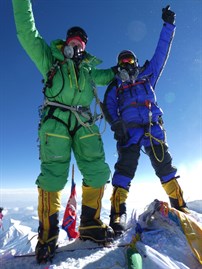
On the top of the world! AAI Collection
Our guide team and Sherpa staff are of the highest caliber in the industry, and our climber-to-guide climbing ratios are lower than that provided by other expedition operators. While we see some other operators foregoing the use of Western Guides in favor of Sherpa-only guiding staff, we know that this places undue pressure on these highly capable but minimally trained people. Instead, our expedition combines the strengths of our guides and Sherpas to operate as a cohesive unit, contributing to a complete, competent, and highly efficient team.
Our collaborative expeditions have a long history of employing the most up-to-date and appropriate technological equipment and systems. We are constantly evolving these systems to ensure we are performing at the highest levels of modern expedition climbing. By incorporating specialized weather forecasting into our ascent program and appling our knowledge base to interpret the forcasts, we set a higher standard of decision making and rate of success. Special focus is placed on catering and sustenance, training our cooking staff to provide excellent meals that earn constant positive feedback from our clients. We employ our own dedicated expedition doctor whose sole purpose is to ensure the ongoing health of the team members, staff, and Sherpas. We also have a qualified Base Camp manager to support the whole team in Base Camp and while they are on the mountain.
An attempt on Mt Everest is a committing undertaking which requires a huge amount of dedication and determination. If you are serious about achieving the top and feel you have the right ingredients and experience, we invite you to apply for a position on our team this season.
Mt. Everest Expedition - South Col
Cost and Details
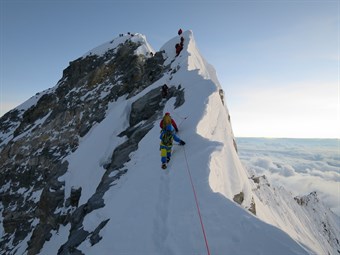 Climbers on the final summit push - credit: Charley Mace
Climbers on the final summit push - credit: Charley Mace
Cost - $83,000
Dates
Oxygen
We provide a high flow oxygen package for all team members included in the expedition fee. Many have found this critical to their success on Everest and we have seen our summit rate increase dramatically with its use. The response from our team members has also been phenomenally positive. Climbers have reported having better energy levels, a better appetite, more warmth, a higher degree of strength and greater enjoyment on summit day. We also ensure we have enough oxygen to wait a day at the South Col and Camp 4, before attempting the summit. Our recent experiences show that for those who really want to maximise their chance of success, then these high oxygen flow rates allow the best option for ensuring you only need to attempt Mount Everest one time!
Additional Services
Extra Sherpa Support
Shouldering a heavy burden can be debilitating at the higher elevations and sap crucial energy levels right when you need it. This option is now included in our standard Everest expedition fee and enables you to carry the equipment you need on a daily basis while we arrange for our Sherpa staff to carry your kit on camp moving days.
Personal Sherpa
Shouldering a heavy burden can be debilitating at the higher elevations and sap crucial energy levels right when you need it. Another service we now include in the expedition price is ‘Additional Sherpa Support’. This enables climbers to forego the carrying of heavy packs, which is often very debilitating at high altitude. For some climbers, the long climb with a pack up to the top camp at South Col can leave them too exhausted for summit day and hence, this service greatly enhances your summit opportunity. We can, however, add an additional layer of support through our Personal Sherpa option. This option provides you with the assistance of a very experienced and dedicated Sherpa who will support you for the duration of the expedition above Base Camp. Your Personal Sherpa will climb with you each day while you are climbing on the mountain as your climbing partner and generally assist you throughout the expedition all the way to the summit. When on the mountain, you would share a tent with your Personal Sherpa and he would supervise cooking duties. Our Sherpa guides are very experienced with multiple ascents of Everest and other high peaks under their belts, and are friendly and supportive companions along the way!
Fast Track Program
For those climbers who wish to maximise their time and are able to pre-acclimatise prior to arriving in Nepal with a system such as Hypoxico, we are able to offer an accelerated Everest expedition schedule with our ‘Fast Track’ program, allowing you to reduce the standard Everest itinerary by 10 days.
Expedition Inclusions and Exclusions
Inclusions:
• 1:4 Western Guide ratio and 1:1 Sherpa to climber ratio on summit day
• Bottled oxygen
• Personal equipment carried on the mountain
• Nepalese government royalty fees
• All expedition organisational requirements
• All climbing and trekking permits
• Fixed-wing air transport within Nepal
• All team equipment
• All expedition staff including Sherpa support
• All food whilst away from Kathmandu
• All supplies necessary to make a safe and strong bid for the summit
• Medical services from our Expedition Doctor
• Base Camp Wi-Fi (fair-use policy applies) and satellite phone facilities
• Internet dispatch page that is updated daily by guides and Base Camp staff, and semi-hourly on summit day
• dZi Foundation support for their “revitalize a village” programme—likely to include support for a Nepalese child’s education for a year.
Exclusions:
• Air travel to and from Nepal
• Hotel accommodation and meals in Kathmandu
• Nepalese airport entry visas
• Extras on the trek in/out such bottled drinks, showers and laundry
• Personal clothing and equipment
• Personal Insurance/Trip Cancellation Insurance/Medical Evacuation Insurance
• Actual satellite phone calls
• Gratuities for guides and Sherpa staff
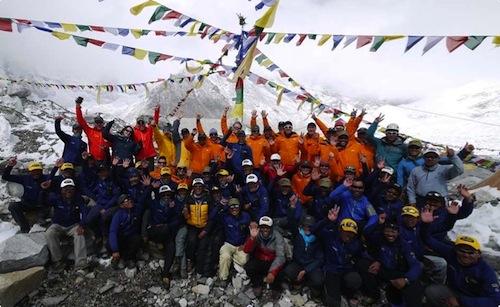
Successful expeditions require excellent team work! AAI/AC Collection.
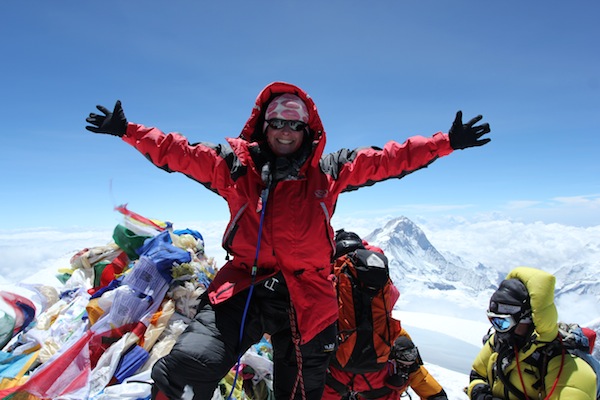
A successful summit of Everest always brings big smiles. Dean Staples
Mt. Everest Expedition - South Col
FAQs
- Why should I choose to climb Everest with your company?
- What is MAX OX / Additional Sherpa Support? How does this work?
- Do you have options for private climbs?/a>
- Can my friends and family come along to base camp for the expedition?
- Because the trip is so long, can I bring food and other gear not on the list?
- How do you train for a trip like this?
- What are the skills/prior experience required for this climb?
- What is the conditioning level needed for this climb?
- How many climbers will be on this expedition?
- Can I contact other climbers or guides for this expedition?
- Will I be sharing a barrel or room with other climbers? Is there a single room option on this trip?
- How heavy will my pack be?
- What kind of food do you have on the mountain? At base camp?
- How long is a typical day on the mountain?
- What type of communication is available on the expedition?
- What sort of hotels do we stay at in the city?
- What time should I arrive and where do I meet my guides?
- How much should I budget for this expedition? How much cash should I plan to bring?
- How much should I tip my guide staff?
- What if I arrive early or depart late?
- Are there any entry or visa requirements?
- What is your cancellation policy? Refund policy?
1. Why should I choose to climb Everest with your company?
We know that when you make a decision to climb Everest it is one of the most financially challenging trips to come on. Our prices compared to other outfitters that provide the same product, if not a lesser product are actually less! We invite you to shop around and compare, both in price and quality. We feel strongly that you will find us to be the best in the business.
One of the main things that sets us apart is our attention to detail. Nowhere else will you find a team of people more dedicated to your success! From the time you contact the office to the time you step on the mountain, our customer service is second to none. We invite you to contact some of our past clients to hear their stories. Contact us at the office for details.
2. What is MAX OX / Additional Sherpa Support? How does this work?
The MaxOx option is simple, in this era of better O2 systems and our quality Sherpa staff, we wanted to offer our team members every possible advantage to summit Mount Everest. The Max Ox O2 option ensures that you will be on the highest possible flow rate per minute that the bottles will allow when we are on O2.
The Additional Sherpa Support option is now included on our standard program and means that at no point on the mountain will you ever have to carry more than what you need for that day. All your camping and incidental equipment is transported between camps by our Sherpa team. To date, everyone, yes everyone who has chosen Max Ox has summited with us.
3. Do you have options for private climbs?
Seeing as your Everest expedition is a once in a lifetime experience, we wanted to make sure you have every possible advantage. Some clients enjoy the added privacy and schedule flexibility that a private expedition allows . A private means you will have your own guides, your share of the Sherpa carry staff, a private dining tent, and optional private communication facilities i. This allows you to climb at your own pace, and enjoy the mountain on your own terms. The costs vary depending on how many clients there in your private group. Please contact the office for details.
4. Can my friends and family come along to base camp for the expedition?
Sure! This is one of the best parts of the start of the expedition, having family and friends trek to base camp to see you off on your journey. Base camp for non-climbers is not a very hospitable place, but we strive to make your guests comfortable and welcome. Guests for the duration of the expedition are allowed on a case by case basis. The reason for this is simple. On the trip, our job is to be climbing, spending time just at base camp can be quite boring sometimes, so we usually encourage guests to trek in at the beginning or end of the expedition, to join you during the most exciting parts of the trip! Contact us for details.
5. Because the trip is so long, can I bring food and other gear not on the list?
Absolutely! Most people on the Everest expedition, members end up bringing “the kitchen sink”! We encourage you to bring some of your favorite goodies and tech toys, as base camp will become our home for 2 months or so. The more comfortable you are, the more energy you have for the climb, so every little thing helps!
6. How do you train for a trip like this?
Our standard response to this question is that for Everest, you become a climber first, and everything else during this portion of your life comes second. This is the level of dedication to your training, both mental and physical, that you need to have. We have specific ideas around training and great book suggestions to help you along. Please contact our office and we will be happy to put you in touch with one of our senior guides for a consultation and we can also link you with our training coach to design a training program for you.
7. What are the skills/prior experience required for this climb?
You cannot just decide to write a check and go and climb Mt. Everest! A comprehensive climbing resume is required to join our team. Usually we look for a few minimum requirements; such as Denali, for the cold and glacier travel experience, and Aconcagua, for the altitude experience. Beyond that, we look for well rounded climbers with a wealth of experience. Summit day experience on an 8000m peak such as Cho Oyu, prior to going to Everest, is highly beneficial. Contact the office for further details and to discuss your individual background.
8. What is the conditioning level needed for this climb?
You should be in the best shape of your life! This is our longest expedition of the year. It requires patience, stamina, mental fortitude, and a strong will. Summit day can sometimes be over 20 hours long! Day by day the challenges are different, but the more prepared you are, both mentally and physically, the smoother your trip will go.
9. How many climbers will be on this expedition?
We have a maximum of 12 members with 3 guides on our Everest expedition, but we have most often had a group size of 8 members with 2 guides in the past few years. This is to ensure we can maintain safety and our attention to detail. There may be more in base camp and in the camps on the mountain if there are private expeditions, but they will generally travel separately from the main team.
10. Can I contact other climbers or guides for this expedition?
Yes, we encourage that. Perhaps there is someone in your area that can become a training partner, perhaps they can help you source some hard to find gear. The bottom line is that it’s a good idea to have some contact with folks that you will share this experience with. We respect the privacy of each team member and check with each person before releasing any contact details.
11. Will I be sharing a barrel or room with other climbers? Is there a single room option on this trip?
You will have your own tent in base camp, but on the mountain, you will be sharing a tent with others. We generally book you in to a single room in the hotel in Kathmandu whilst it is twin share in the lodges on the trek into base camp. A single supplement is available. Please contact our office for further details.
12. How heavy will my pack be?
The weight of your pack will usually not exceed 10-15 lbs (5-7 kg). What used to happen was on a “carry” day, where you moved your personal gear between camps, your pack would be 20-40 lbs (9-18 kg), sometimes higher if you chose to carry more of your equipment and on “move” days, the weight went down to 10-15 lbs (5-7 kg). Now, since we include carrying your personal overnight gear as part of the expedition, your pack weight is always in the 10-15 lbs (5-7 kg) range.
13. What kind of food do you have on the mountain? At base camp?
This will depend on what camp we are in. In base camp, we import tons of food from the USA and New Zealand. So don’t be surprised by our sushi nights, fresh muffins, yoghurt for breakfast, and pizza! On the mountain we usually have a wide variety of MRE meals, these are significantly tastier than freeze dried, as they are real food vacuum sealed and ready to heat and eat! At Camp 2, our advanced base camp, we have Sherpa cook staff, who prepare more ‘base camp like’ food. Pizza, pasta, eggs and bacon! We work really hard to make sure our food is second to none. As evidence of this, other companies have tried to steal Chongba, our master chef, over to their companies!
14. How long is a typical day on the mountain?
It depends on the day and your level of acclimatization. At the beginning of the trip, everything seems slower and longer, but as you get more adjusted to the mountain, the days go quicker. Average days can be 5-10 hours long. Summit day can be up to 20 hours long.
15. What type of communication is available on the expedition?
We have one of the most sophisticated communication systems around. Email, phone calls, and even Skype video calls are available at base camp for a fee and we power our whole set up with solar, using generators only as backup. On the mountain, we discourage phone calls as they distract from the climb and we often are limited by our power availability. If you need a private communications setup, this is also possible for a fee. Contact our office for details.
16. What sort of hotels do we stay at in the city?
We stay at the Hotel Shanker in Kathmandu, in the Lazimpat area which is not far from Thamel. It is actually an old royal palace, complete with a huge tranquil garden, swimming pool, and attached spa! A perfect place to begin and end your trip. We also have team members staying at the nearby Raddisson suites as a second option.
17. What time should I arrive and where do I meet my guides?
Before your expedition you will receive a final trip letter. This will inform you about time and place you will be meeting your guides. On this trip, there will be an AAI/AC representative at the airport to meet you, and the first of many team briefing occurs on the evening of day 1.
18. How much should I budget for this expedition? How much cash should I plan to bring?
As this is our biggest and longest trip, we usually suggest members to bring US$1000 - $2000. This will cover everything from gifts, to bottled drinks, tips, and anything else that catches your eye on the trail. ATM cash machines work in Kathmandu, but only give the local currency, Rupees.
19. How much should I tip my guide staff?
This is a difficult thing to gauge. We have seen everything from US$20 to US$15,000 for an Everest expedition tip. Tipping is not required, but a small way to show your guides thanks for their help. The level of the tip should reflect the level of personal involvement with your guide.
20. What if I arrive early or depart late?
On a trip as long as this, we request that you arrive in Kathmandu on the assigned date, to assure your baggage makes it on time, and you have time to recover from jet lag before trekking. It is hard to catch the group if you are arriving late and still waiting for lost baggage! We can arrange extra nights in the hotel. Many people depart from our Nepal expeditions later, to enjoy the sights and sounds of Kathmandu, but do keep in mind that this is long expedition and we find that people want to head home as quickly as possible after the climb finishes.
21. Are there any entry or visa requirements?
Yes there are. You can print the forms from http://treks.com.np/visa or you can complete them on the plane as the forms are handed out on your arrival flight into Kathmandu. Be sure to have the suggested USD amount in cash for your visa application and have a passport photo for your arrival in Kathmandu. Currently a 90 day visa costs US$100.
22. What is your cancellation policy? Refund policy?
An expedition member may cancel his/her participation on the following basis:
a) prior to January of the expedition year then on the basis of a 50% refund
b) after January of the expedition year, but before departure to the mountain from Kathmandu then no refund.
Travel insurance and trip cancellation insurance is highly recommended, as an injury, a work issue or a family emergency would not qualify you for a tuition credit or reimbursement.